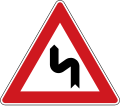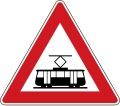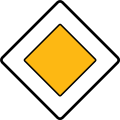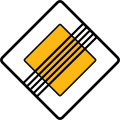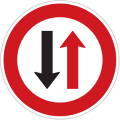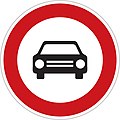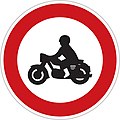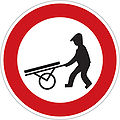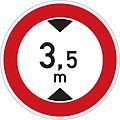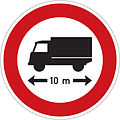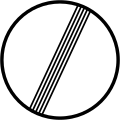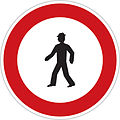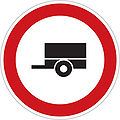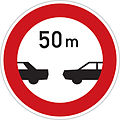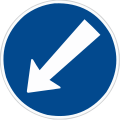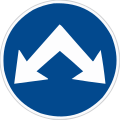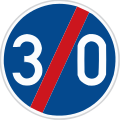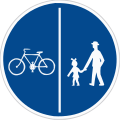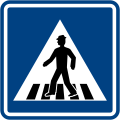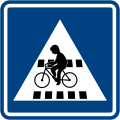
Road signs in Sweden are regulated in Vägmärkesförordningen, VMF (2007:90), and are to be placed 2 metres from the road with the sign 1.6 m from the base for motorized roads. Except for route numbers, there are a maximum of three signs on a pole, with the most important sign at the top. All signs have a reflective layer added on selected parts of the sign as is custom in European countries; most larger signs also have their own illumination.
Road signs in Singapore closely follow those laid down in the traffic sign regulations used in the United Kingdom, although a number of changes over the years have introduced some slight deviations that suit local road conditions. Road signs in Singapore conform to the local Highway Code under the authority of Singapore Traffic Police.

Road signs in Norway are regulated by the Norwegian Public Roads Administration, Statens vegvesen in conformity with the 1968 Vienna Convention on Road Signs and Signals, to which Norway is a signatory.

Road signs in Iceland are visual communication devices placed along roads and highways throughout the country to provide information, warnings, and guidance to motorists and pedestrians. Iceland never ratified the Vienna Convention on Road Signs and Signals, but road signs in Iceland conform to the general pattern of those used in most other European countries, with certain design elements borrowed from Danish and Swedish practice. Signs tend to be more sparsely employed than in other European countries, especially in rural areas.

Road signs in Italy conform to the general pattern of those used in most other European countries, with the notable exception that the background of motorway (autostrada) signs is green and those for 'normal' roads is blue. They are regulated by the Codice della Strada and by the Regolamento di Attuazione del Codice della Strada in conformity with the 1968 Vienna Convention on Road Signs and Signals.

The design of road signs in Poland is regulated by Regulation of the Ministers of Infrastructure and Interior Affairs and Administration on road signs and signals. The Annex 1 to the regulation describes conditions related to usage of the road signs – size, visibility, colors and light reflections, typeface and text, criteria of choosing the type of foil to signs faces, colorful specimens and schematics.

Road signs in Israel are regulated by the Ministry of Transportation in the Division of Transportation Planning, most recently set forth in June 2011.

The road signs of the Kingdom of the Netherlands, as well as Suriname, are regulated in the Reglement verkeersregels en verkeerstekens 1990, commonly abbreviated as RVV 1990. While most previous signage, from the RVV 1966 (Dutch) remained legal and official, they have been updated / replaced. Some aren't official anymore and have lost legal validity, but most surviving old signs remained valid.

Road signs in South Korea are regulated by the Korean Road Traffic Authority.

Road signs in Switzerland and Liechtenstein generally conform to the 1968 Vienna Convention on Road Signs and Signals.
Road signs in Ukraine are governed by a combination of standards set out by the Vienna Convention on Road Signs and Signals, the European Union (EU), and Ukraine Transport and Roads Agency. Ukrainian signs are similar to the signs of other post-Soviet states and are set out in 7 separate categories based on meaning: warning, priority, prohibitory, mandatory, information, service, and additional plates.

Road signs in Hong Kong are standardised by the Transport Department. Due to being a former British territory, the road signage in Hong Kong is similar to road signs in the United Kingdom, with the addition of Traditional Chinese characters.

Road signs in France refer to all conventional signals installed on French roads and intended to ensure the safety of road users, either by informing them of the dangers and regulations relating to traffic as well as elements useful for decision-making, or by indicating to them the landmarks and equipment useful for their travel on the national territory. They generally largely follow the general European conventions concerning the use of shape and color to indicate their function. France is a signatory to the 1968 Vienna Convention on Road Signs and Signals. France signed the Vienna Convention on Road Signs and Signals on 8 November 1968 and ratified it on 9 December 1971.

Road signs in Georgia are similar to the road sign system of other post-Soviet states that ensure that transport vehicles move safely and orderly, as well as to inform the participants of traffic built-in graphic icons. However, some road signs look a bit different from Soviet ones and closer to the European ones. These icons are governed by the Vienna Convention on Road Traffic and Vienna Convention on Road Signs and Signals.

Road signs in Kyrgyzstan are similar to the road sign system of other post-Soviet states that ensure that transport vehicles move safely and orderly, as well as to inform the participants of traffic built-in graphic icons. These icons are governed by the Vienna Convention on Road Traffic and Vienna Convention on Road Signs and Signals.

Road signs in Lithuania conform to the general pattern of those used in most other European countries as set out in the 1968 Vienna Convention on Road Signs and Signals. Due to the country being occupied and annexed by the Soviet Union between 1940 and 1990, when it restored its independence, modern road signs used in Lithuania are in many ways similar in design to road signs used in the Soviet Union before its dissolution in 1991. This design of road signs is still used in most post-Soviet states, in particular Russia, Belarus, and Ukraine. Neighboring post-Soviet Baltic countries Latvia and Estonia, which were also occupied by the Soviet Union in 1940, have significantly modified their road sign designs, resulting road signs in these two countries being extremely different in design from road signs used in most other post-Soviet states.
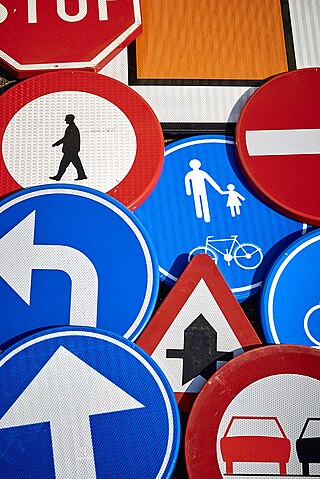
Road signs in Belgium are defined in the Royal Decree of 1 December 1975 on general regulations for the road traffic police and in the use of public highways. They generally conform to the 1968 Vienna Convention on Road Signs and Signals. The official typeface on road signs in Belgium is SNV.

Road signs in the Republic of Bulgaria were introduced by the Road Traffic Act and are regulated by:
Road signs in Latvia conform to the general pattern of those used in most other European countries. They are regulated in Ceļu satiksmes noteikumi and the standards documents LVS 77–1:2016 "Ceļa zīmes. 1. daļa: Ceļa zīmes", LVS 77-2:2016 "Ceļa zīmes. 2. daļa: Uzstādīšanas noteikumi" and LVS 77-3:2016 "Ceļa zīmes. 3. daļa: Tehniskās prasības" in conformity with the 1968 Vienna Convention on Road Signs and Signals. Latvia acceded to the Vienna Convention on Road Signs and Signals on October 19, 1992.

Road signs in Croatia are regulated in Pravilnik o prometnim znakovima signalizaciji i opremi na cestama. The shape and design of the road signs largely follow the road signs used in most European countries, including European Union countries, to which Croatia joined in 2013. A similar design of road signs is used in the neighboring countries of the former Yugoslavia like Slovenia, Bosnia and Herzegovina, and also North Macedonia.




